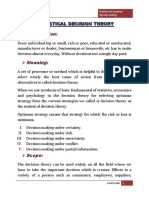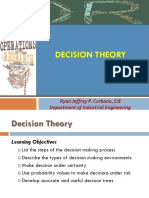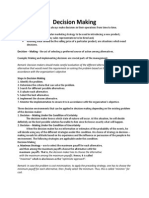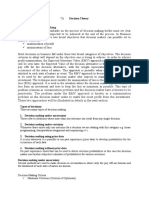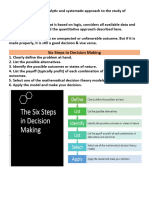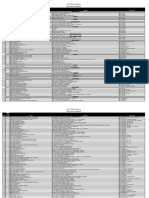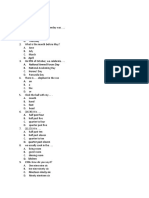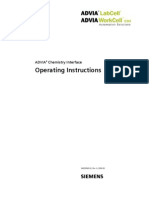0 ratings0% found this document useful (0 votes)
22 viewsAccounting For Decision Making III
Accounting For Decision Making III
Uploaded by
Cornelio SwaiThe document discusses three decision rules for decision making under uncertainty: maximax criterion, maximin criterion, and minimax regret criterion. It also discusses expected value and expected opportunity loss criteria for decision making under risk. The maximax criterion selects the alternative with the highest possible payoff. The maximin criterion selects the alternative with the highest minimum payoff to avoid the greatest loss. The minimax regret criterion selects the alternative with the lowest maximum regret.
Copyright:
© All Rights Reserved
Available Formats
Download as PPTX, PDF, TXT or read online from Scribd
Accounting For Decision Making III
Accounting For Decision Making III
Uploaded by
Cornelio Swai0 ratings0% found this document useful (0 votes)
22 views16 pagesThe document discusses three decision rules for decision making under uncertainty: maximax criterion, maximin criterion, and minimax regret criterion. It also discusses expected value and expected opportunity loss criteria for decision making under risk. The maximax criterion selects the alternative with the highest possible payoff. The maximin criterion selects the alternative with the highest minimum payoff to avoid the greatest loss. The minimax regret criterion selects the alternative with the lowest maximum regret.
Original Title
Accounting for Decision Making III
Copyright
© © All Rights Reserved
Available Formats
PPTX, PDF, TXT or read online from Scribd
Share this document
Did you find this document useful?
Is this content inappropriate?
The document discusses three decision rules for decision making under uncertainty: maximax criterion, maximin criterion, and minimax regret criterion. It also discusses expected value and expected opportunity loss criteria for decision making under risk. The maximax criterion selects the alternative with the highest possible payoff. The maximin criterion selects the alternative with the highest minimum payoff to avoid the greatest loss. The minimax regret criterion selects the alternative with the lowest maximum regret.
Copyright:
© All Rights Reserved
Available Formats
Download as PPTX, PDF, TXT or read online from Scribd
Download as pptx, pdf, or txt
0 ratings0% found this document useful (0 votes)
22 views16 pagesAccounting For Decision Making III
Accounting For Decision Making III
Uploaded by
Cornelio SwaiThe document discusses three decision rules for decision making under uncertainty: maximax criterion, maximin criterion, and minimax regret criterion. It also discusses expected value and expected opportunity loss criteria for decision making under risk. The maximax criterion selects the alternative with the highest possible payoff. The maximin criterion selects the alternative with the highest minimum payoff to avoid the greatest loss. The minimax regret criterion selects the alternative with the lowest maximum regret.
Copyright:
© All Rights Reserved
Available Formats
Download as PPTX, PDF, TXT or read online from Scribd
Download as pptx, pdf, or txt
You are on page 1of 16
Accounting for Decision Making III
BAC IIII, BTX III, BBF III
Decision-making under Uncertainty
Under conditions of uncertainty, the decision-
maker is not able to assign probabilities to the
possible states of nature.
A number of decision rules to cater for
different attitudes of managers have been
formulated.
In this section we shall look at three decision
rules,
The maximax criterion, the maximin
criterion, and the minimaxregret criterion.
Maximax Criterion
This criterion is applied by identifying the highest
outcome (or maximum payoff) that can be obtained
for each alternative being considered.
These maximum payoffs are compared. The
alternative that promises the highest maximum
payoff is selected.
The decision rule applied by the decision maker is:
MAXImise MAXimum payoffs.
Steps
Construct a payoff table (also known as payoff matrix or
conditional profit table).
For each alternative course of action, list down the
maximum possible outcomes.
Identify the highest outcome from the list produced in
Step 2.
Select the alternative that yields that outcome.
These four steps are applied below.
Example
An investor is considering three investment alternatives known as
X, Y and Z. The payoff (benefit) from these investments depends
upon the level of economic activity in the future, and the following
estimates have been made.
Pay off table (all figures in Shs’000):
State of Nature
Alternative X Y Z
Expansion 100 52 - 45
Stability 50 110 0
Contraction - 50 - 25 180
Which investment should the investor choose?
Maximax Criterion
This criterion is applied by identifying the highest outcome (or maximum
payoff) that can be obtained for each alternative being considered.
These maximum payoffs are compared. The alternative that promises the
highest maximum payoff is selected.
The decision rule applied by the decision maker is: MAXImise MAXimum
payoffs.
Steps
1. Construct a payoff table (also known as payoff matrix or conditional
profit table).
2. For each alternative course of action, list down the maximum possible
outcomes.
3. Identify the highest outcome from the list produced in Step 2.
Select the alternative that yields that outcome.
4. These four steps are applied below.
Payoff Table…Example 1
If we select investment A, the maximum payoff we can ever expect to
earn is Shs.100,000; if we select investment Y, the highest payoff
possible is Shs.110,000: and should we select investment Z, the best we
can hope for is Shs.180,000.
Action Maximum Payoff
Shs. ‘000
X 100
Y 110
Z 180
The highest outcome from the above list:
The highest payoff from the above list of maximum payoffs is
Shs.180,000, promised by Investment Z.
Select the alternative that yields that outcome
Therefore, using maximax criterion, investment Z should be selected.
Maximin Criterion
This criterion is applied by identifying the lowest outcome (or
minimum payoffs) that can be obtained for each alternative
being considered. These minimum payoffs are compared.
The alternative associated with the best of these lowest
outcomes is selected. The idea is to avoid the alternative that
yields the lowest profit or one that yields the highest loss.
The decision rule applied by the decision maker is: MAXImise
the MINimum payoffs. This criterion, when expressed in terms
of losses (or negative payoffs), is also known as minimax
criterion. The rule in this case is MINimise the MAXimum
losses.
Steps
1. Construct a payoff.
2. For each alternative course of action, list down the minimum possible
outcome.
3. Identify the highest outcome from the list produced in Step 2.
4. Select the alternative that yields that outcome.
Considering the previous example, minimum payoff will be:
Action Minimum Payoff
Shs ‘000
X - 50
Y - 25
Z - 45
Of these possible losses, the least is a loss of Shs.25,000 which could arise
if we invested in investment B and the economy turned out to be stable.
Therefore, using maximin criterion, we select investment Y.
Minimax regret
The above two criteria make use of a payoff table or
payoff matrix. A payoff table shows the outcome for
each course of action conditional upon the occurrence
of each state of nature. The third criterion, the
minimax regret, makes use of a regret matrix or
opportunity loss matrix.
This criterion is applied by identifying the highest
opportunity loss (or maximum regret) that can arise
for each alternative being considered. From these
regrets, the lowest is identified and the associated
course of action is selected.
The Opportunity losses are obtained by:
Identifying the optimal course of action for each state of nature; and
1. Calculating, under each state of nature, the loss that would arise
from selecting a particular course of action rather than the optimal
choice.
Steps
1. Construct a regret matrix (also known as an opportunity loss
table).
2. For each alternative course of action, list down the maximum
regrets.
3. Identify the lowest regret from the list produced in Step 2.
4. Select the alternative that generates that regret.
Constructing a regret matrix
Regret is the cost, to the decision maker, of being uncertain. If
the decision maker knew with certainty which state of nature, he
was going to obtain in the future, he/she would select the option
that yields the highest outcome under that particular state of
nature.
Based on the previous example, the following regret matrix:
State of Nature
Alternative Expansion Stability
Contraction
X 0 60 230
Y 48 0 205
Z 145 110 0
Regret table
We extract the following data:
Action Maximum Regret
Shs ‘000
X 230
Y 205
Z 145
The lowest regret is Shs.145,000 which is associated
with Investment Z.
We therefore would select Investment Z, under the
Minimax regret criterion.
Decision Making Under Conditions of Risk
Under conditions of risk, the decision-maker is able to
assign probabilities to the possible states of nature.
The assignment of probabilities, among other things,
enables the decision-maker to calculate expected
values.
Two decision criteria, the expected value (EV)
criterion and the expected opportunity loss (EOL)
criterion are discussed using example below.
Example 2
Assume the same data as in Example 1 above, with
the following additional information.
State of Nature Probability of Occurrence
Expansion 0.20
Stability 0.45
Contraction 0.35
Solution
Expected values for each of the three options X, Y,
and Z on the basis of the information in Example 2,
are as follows:
EV (Shs ‘000)
X (0.2 x 100) + (0.45 x 50) + (0.35 x -50) = 25.0
Y (0.2 x 52) + (0.45 x110) + (0.35 x -25) = 51.15
Z (0.2 x -45) + (0.45 x 0) + (0.35 x 180) =
54.0
On the basis of expected values, Investment Z is the
best, and should therefore be chosen
You might also like
- Decision TheoryDocument35 pagesDecision TheoryPushpa Latha M100% (1)
- Decision AnalysisDocument37 pagesDecision AnalysisMay Ann Agcang SabelloNo ratings yet
- Casio PT-82Document7 pagesCasio PT-82vialichNo ratings yet
- Re-Evaluation of DNV Simplified Formulae For Crane Tip MotionsDocument10 pagesRe-Evaluation of DNV Simplified Formulae For Crane Tip Motionsguxiaom100% (1)
- Unit 6 - 1 Risk and UncertaintyDocument7 pagesUnit 6 - 1 Risk and Uncertaintyharsimrankaur2493No ratings yet
- Decision Theory: Defective Chips at A Rate of 1 in 3Document6 pagesDecision Theory: Defective Chips at A Rate of 1 in 3swatiraj05No ratings yet
- Unit 5Document44 pagesUnit 5Alemayehu gabisaNo ratings yet
- Reflection+ 4Document7 pagesReflection+ 4tlakshmisoumyaNo ratings yet
- Statistical Decision TheoryDocument8 pagesStatistical Decision Theoryrahul khuntiNo ratings yet
- OR Unit 4Document14 pagesOR Unit 4sakshi narayanNo ratings yet
- MS ReportDocument18 pagesMS ReportCygresy GomezNo ratings yet
- Quantitative Business Analysis Practice Exercises Chapter 3 - SolutionsDocument7 pagesQuantitative Business Analysis Practice Exercises Chapter 3 - SolutionstableroofNo ratings yet
- Chapter 16 - Decision AnalysisDocument61 pagesChapter 16 - Decision AnalysisHoàng Hiểu YếnNo ratings yet
- Decision Theory PresentationDocument35 pagesDecision Theory PresentationEduard Santos Cruz100% (3)
- Decision Theory Model - Lec03.1Document29 pagesDecision Theory Model - Lec03.1Libres Twin100% (1)
- Trust and PaymentDocument5 pagesTrust and PaymentayinaNo ratings yet
- 3 Decision Making - 220316 - 183249Document29 pages3 Decision Making - 220316 - 183249KOFI BROWN100% (1)
- Decision TheoryDocument32 pagesDecision TheoryAmul Shrestha100% (1)
- Decision Making Under Risk and Uncertainity 5.1. The Nature of Decision MakingDocument9 pagesDecision Making Under Risk and Uncertainity 5.1. The Nature of Decision MakingKaleab EnyewNo ratings yet
- Chapter 4 & 5 ORDocument13 pagesChapter 4 & 5 ORkalkidankebede440No ratings yet
- Chapetr 4 BADocument15 pagesChapetr 4 BAsuleymantesfaye10No ratings yet
- Managerial Chapter 5PPTDocument17 pagesManagerial Chapter 5PPTsolizasoli16No ratings yet
- GE CEE Presentation EditedDocument27 pagesGE CEE Presentation EditedDev SinghNo ratings yet
- LESSON 2 Decision Making EnvironmentDocument7 pagesLESSON 2 Decision Making EnvironmentArnold MianoNo ratings yet
- Decision AnalysisDocument59 pagesDecision AnalysissnehalNo ratings yet
- 08 Handout 1Document10 pages08 Handout 1JamesdanJavierNo ratings yet
- Decision TheoryDocument30 pagesDecision TheoryRISHAB NANGIANo ratings yet
- Decision TreeDocument26 pagesDecision TreePriya GaNo ratings yet
- Artificial Intelligence Assignment 2Document8 pagesArtificial Intelligence Assignment 2natasha ashleeNo ratings yet
- Chapter Four: Decision TheoryDocument45 pagesChapter Four: Decision TheoryAshenafi hunegnawNo ratings yet
- Operation Research Chapter Four 4. Decision Theory/Analysis Unit ObjectiveDocument7 pagesOperation Research Chapter Four 4. Decision Theory/Analysis Unit Objectivebirukketema046No ratings yet
- Decision AnalysisDocument19 pagesDecision Analysissamim25feb2904No ratings yet
- PRM CH7Document49 pagesPRM CH7YIBELTAL MEKUANNETNo ratings yet
- DecisionTheory Ch8Document57 pagesDecisionTheory Ch8Alex BantonNo ratings yet
- Decision MakingDocument9 pagesDecision MakingNathallie CabalunaNo ratings yet
- Lesson 12 - Decisions Recognizing Risk and Decisions Admitting UncertaintyDocument45 pagesLesson 12 - Decisions Recognizing Risk and Decisions Admitting UncertaintyJonel YsaisNo ratings yet
- Decision TheoryDocument19 pagesDecision TheoryShilpi RaiNo ratings yet
- Decisionth 1Document66 pagesDecisionth 1Vijayant Panda100% (1)
- QTFMDocument39 pagesQTFMHarsh SinghNo ratings yet
- Operations ResearchDocument31 pagesOperations ResearchPriya PatilNo ratings yet
- Importance of Decision Making Decision Making: The StepsDocument5 pagesImportance of Decision Making Decision Making: The Stepsshahid_hussain_41No ratings yet
- Chapter 5 MEDocument5 pagesChapter 5 MEosmanaddis16No ratings yet
- Chapter 5 Decision TheoryDocument85 pagesChapter 5 Decision TheoryKristelle Joy PascualNo ratings yet
- Decision AnalysisDocument27 pagesDecision AnalysisneffhbaculodmzNo ratings yet
- Decision TheoryDocument30 pagesDecision TheoryJuhi SiddiquiNo ratings yet
- Boston International College MBA II Trimester Emerging Concept of ManagementDocument14 pagesBoston International College MBA II Trimester Emerging Concept of ManagementUmesh SahNo ratings yet
- Reviewer Decision TheoryDocument8 pagesReviewer Decision TheoryJeraldine CanariaNo ratings yet
- HACC207-Physical Class Statistical Decision Theory Class NoteDocument9 pagesHACC207-Physical Class Statistical Decision Theory Class Notejimoh kamiludeenNo ratings yet
- W 9 & 11 (Introduction To Decision Analysis)Document55 pagesW 9 & 11 (Introduction To Decision Analysis)asadNo ratings yet
- What Is Management Science?Document16 pagesWhat Is Management Science?MadhurGuptaNo ratings yet
- Decision TheoryDocument14 pagesDecision TheoryfuriousTaherNo ratings yet
- Objective of Decision MakingDocument5 pagesObjective of Decision Makingouko kevinNo ratings yet
- Decision TheoryDocument14 pagesDecision TheoryrishavNo ratings yet
- CH 2 QuantatativeDocument14 pagesCH 2 QuantatativeAhmed MohamedNo ratings yet
- Module 3 BDADocument23 pagesModule 3 BDAARYA MURALI ECE-2020-24No ratings yet
- MaximaxDocument3 pagesMaximaxramniwas sharmaNo ratings yet
- Decision TheoryDocument10 pagesDecision Theorysonali guptaNo ratings yet
- Chapter 4,5 QuantDocument82 pagesChapter 4,5 Quantwondosen birhanuNo ratings yet
- Investor's Mental Models: Mental Models Series, #3From EverandInvestor's Mental Models: Mental Models Series, #3Rating: 5 out of 5 stars5/5 (1)
- Standard Costing and Variance AnalysisDocument37 pagesStandard Costing and Variance AnalysisCornelio SwaiNo ratings yet
- Airline Finance 5th EdnDocument48 pagesAirline Finance 5th EdnCornelio SwaiNo ratings yet
- Transport Cost and BenefitsDocument49 pagesTransport Cost and BenefitsCornelio SwaiNo ratings yet
- Marine CostsDocument20 pagesMarine CostsCornelio SwaiNo ratings yet
- BMU 07312 Test TwoDocument2 pagesBMU 07312 Test TwoCornelio SwaiNo ratings yet
- SpecialDocument2 pagesSpecialCornelio SwaiNo ratings yet
- 10 1 1 741 5971Document11 pages10 1 1 741 5971Mariel A. HaliliNo ratings yet
- RTU 61850 RecommendationsDocument2 pagesRTU 61850 RecommendationsFikret ŞafakNo ratings yet
- ProposedTIA1054NFPA13 - ProposedTIA1054NFPA13Document7 pagesProposedTIA1054NFPA13 - ProposedTIA1054NFPA13daniela hritucNo ratings yet
- Abbottabad: City Wise S. No. Name Address Phone NoDocument4 pagesAbbottabad: City Wise S. No. Name Address Phone NoQasimMalikNo ratings yet
- PDF Advanced Accounting (Twelfth Edition) Paul Fischer downloadDocument55 pagesPDF Advanced Accounting (Twelfth Edition) Paul Fischer downloadfrancqayatinNo ratings yet
- Module TX003 Types On Income TaxpayersDocument3 pagesModule TX003 Types On Income TaxpayersErvin Ray FernandezNo ratings yet
- Crusher SLD-Model - PDF June 2Document1 pageCrusher SLD-Model - PDF June 2iqbal husseinNo ratings yet
- Martin Et Al. (2019)Document21 pagesMartin Et Al. (2019)Gabriel González GarcíaNo ratings yet
- GDPR Compliance For Philippine Based PICs and PIPsDocument6 pagesGDPR Compliance For Philippine Based PICs and PIPsAce Reblora IINo ratings yet
- Инструкция Webasto ConditionerDocument12 pagesИнструкция Webasto ConditionerНиколаевский Тепловозоремонтный ЗаводNo ratings yet
- Selected Water Res 2111988 WateDocument740 pagesSelected Water Res 2111988 Wateacademo misirNo ratings yet
- TQ BlockchainDocument22 pagesTQ Blockchainnacho carlinoNo ratings yet
- 8 BP WEEK 6 - Create FlowchartDocument9 pages8 BP WEEK 6 - Create FlowchartKathrine CadalsoNo ratings yet
- Machine 5 PrintDocument12 pagesMachine 5 PrintLove Nepal Is BackNo ratings yet
- Massey Ferguson MF 2725 TRACTOR Service Parts Catalogue Manual (Part Number 1637160)Document16 pagesMassey Ferguson MF 2725 TRACTOR Service Parts Catalogue Manual (Part Number 1637160)qlb898316No ratings yet
- C. Friday: Choose The Correct Answer!Document9 pagesC. Friday: Choose The Correct Answer!Salsa NadhifaNo ratings yet
- The Phillips Curve and Its ModificationsDocument26 pagesThe Phillips Curve and Its Modificationszanga_m3dNo ratings yet
- The Role of Geomatics Engineering EducatDocument6 pagesThe Role of Geomatics Engineering EducatRaffy GalutanNo ratings yet
- Rules For The Classification of Ships, Pt. 1, Ch.1, 2014Document29 pagesRules For The Classification of Ships, Pt. 1, Ch.1, 2014Suseprianus PatumbaNo ratings yet
- CIP Validation ToolDocument2 pagesCIP Validation ToolMarivic AlegriaNo ratings yet
- Born in Africa Newsletter December 2018Document8 pagesBorn in Africa Newsletter December 2018Jaak LeenknegtNo ratings yet
- Pharma PH.D Entrance Exam SyllabusDocument5 pagesPharma PH.D Entrance Exam SyllabusbiopharmacyNo ratings yet
- R44 Inspection ListDocument2 pagesR44 Inspection ListskytacticaeroNo ratings yet
- Minute Maid Case StudyDocument2 pagesMinute Maid Case StudyEhab DanielNo ratings yet
- LEED v4.1 O M Guide 020623 1Document77 pagesLEED v4.1 O M Guide 020623 1adughmiNo ratings yet
- Understanding The Self Module 2 The Self Society and CultureDocument10 pagesUnderstanding The Self Module 2 The Self Society and CultureKrisChan ProdNo ratings yet
- Company Profile 2022 HCE - Rev2.m PDFDocument79 pagesCompany Profile 2022 HCE - Rev2.m PDFPravash MoolNo ratings yet
- Advia Chemistry Analyzer Advance InforDocument56 pagesAdvia Chemistry Analyzer Advance Inforteeeraj100% (2)








